Subjects:
- Preface
- Permanent magnet stepper motor (PM type)
- Variable Reluctance Stepper Motor (VR)
- Hybrid Stepper Motor
Preface:
As the name suggests, a stepper motor can be set in several steps. The number of steps may vary. Depending on the application, the stepper motor can adjust from 4 to 200 steps per rotation, which can mean a controlled rotation from 0,8° rotor rotation.
The angular rotation can be determined very accurately with a stepper motor. The stepper motor is in fact a synchronous DC electric motor without carbon brushes, because the parts and control methods have many similarities, but this DC motor is nevertheless distinguished by the following properties:
- A stepper motor has a relatively large torque at low speeds and can therefore start up very quickly from standstill;
- The movement of a stepper motor is slow and very accurate. The DC motor is applied to be able to run fast for a long time;
- The rotational speed and position of the stepper motor is controlled by a drive signal from the control unit. As a result, no position sensor or any other form of feedback is needed;
- A stepper motor makes more noise and causes more vibration compared to a brushless DC motor.
The stepper motor is used in many places in the car to make parts make a controlled electrical movement. Below are three applications in which the stepper motor can be found, namely: for the idle control, the indicators in the instrument panel and the heater valves for the ventilation control.
Idle control stepper motor:
The throttle of a gasoline engine is closed at rest. A small opening is required to allow the engine to idle. The diameter must also be adjustable, because the temperature and load (eg when consumers are switched on, such as the air conditioning pump) influence the required amount of air drawn in.
In modern engines, the position of the throttle is precisely controlled. We also find systems in which the gas valve is completely closed and the air is routed around the gas valve via a bypass (bypass) control. The air circulation can be realized via a PWM-controlled DC motor as well as via a stepper motor. See the page about the throttle.
The three images below are of a stepper motor that serves as an idle controller. The opening of the bypass is controlled by the shaft with the conical end. Twisting the armature in the stepper motor causes the worm wheel to twist.
- Counterclockwise rotation: worm gear rotates inwards (large gap in the bypass);
- Clockwise rotation: worm gear rotates outwards (small gap in the bypass).
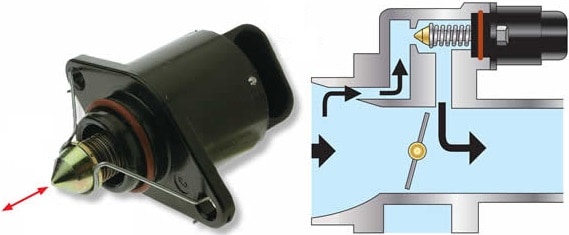
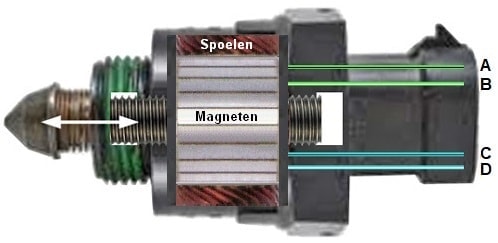
Instrument panel:
The instrument panel is often equipped with several stepper motors for the tank level gauge, speedometer, tachometer, engine temperature and in the example below also the consumption meter below the tachometer. The instrument panel of a BMW is shown below.
At the rear (inside) of the instrument panel we find the five stepper motors with black housing. On the right we see the relevant stepper motor without housing. Here you can clearly see the two coils and the four connections (two on the left, two on the right) from which we can recognize the bipolar stepper motor. The stepper motor can adjust the needles in small steps. The command to adjust comes from the ECU in the instrument panel.
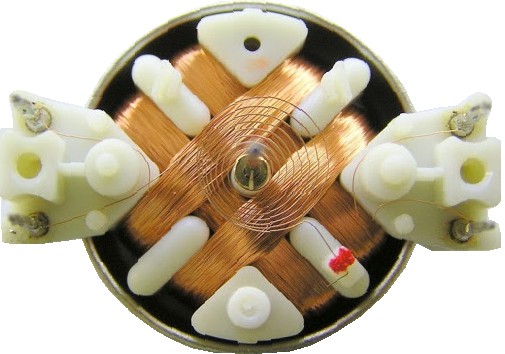
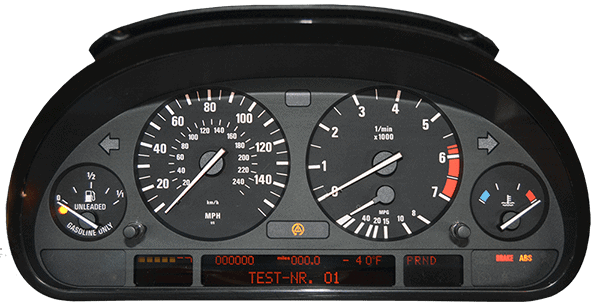
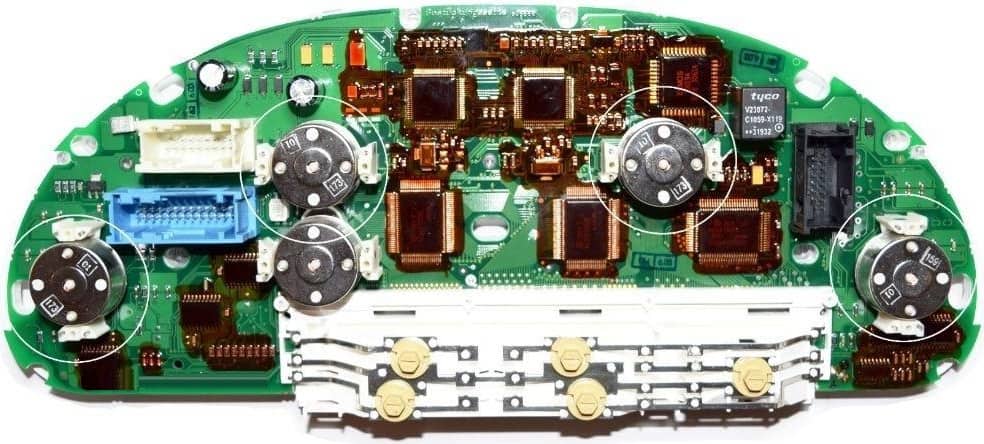
The following diagram shows the inputs and outputs of the stepper motor driver. This is the IC in the instrument panel that translates incoming information into an output for the stepper motor:
- fuel level in the tank (tank float);
- vehicle speed (pulse generator in gearbox or ABS sensors);
- engine speed (crankshaft position sensor);
- temperature (coolant temperature sensor).
In the block diagram, the red and green arrows indicate the connections (A to D) on the coils in the stepper motor.
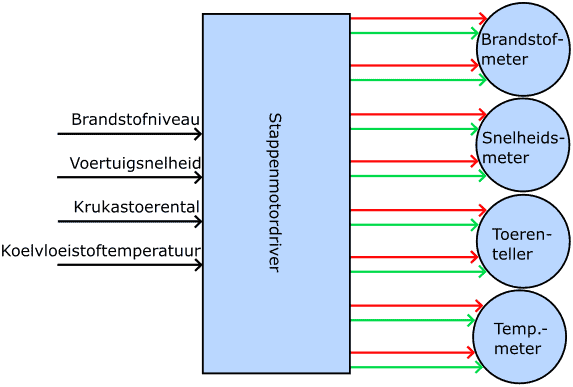
Air deflection valves in the stove housing:
We often find stepper motors in the electronically operated air vent valves in the stove house. The images below show a photo of an air temperature valve (left) and an illustration of its installation position (right). The stepper motor operates the valve by means of the mechanism, in which number 4 in the illustration indicates the pivot point. In case of incorrect functioning of the stepper motor, or after replacement, the start and end position in the ECU must be made known. With diagnostic equipment we can teach the valve stops so that the ECU knows when the valve is fully open or closed, so that it can also determine how long it needs to drive the stepper motor to partially open the valve.
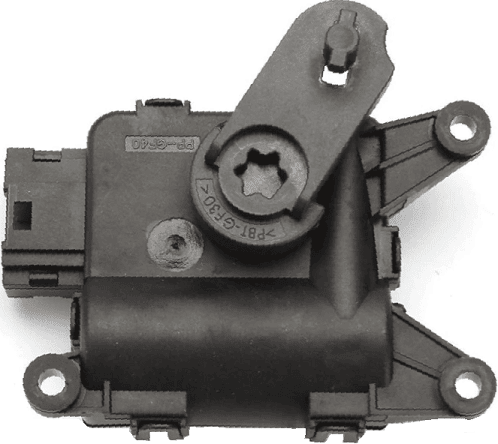
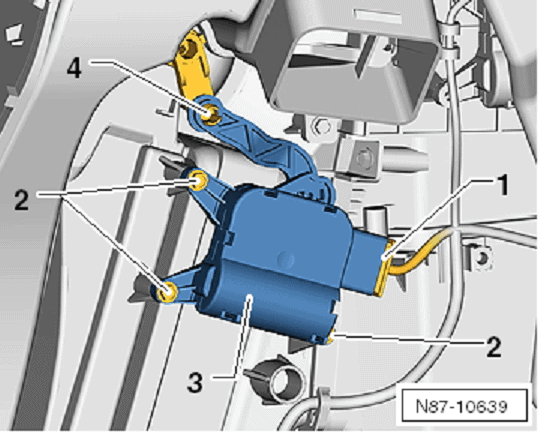
Permanent magnet stepper motor (PM type):
This type of stepper motor has a rotor with a permanent magnet. The advantage of this stepper motor is its simple construction and therefore a low cost price. Below is information about the operation of this stepper motor.
The rotor of the stepper motor can make a full rotation with multiple intermediate steps. In the example in the four images below, four intermediate steps per rotation are shown. The rotor can therefore be stopped every 90 degrees. The left stepper motor is in position 1, with the north pole of the rotor at the top and the south pole at the bottom. To move the rotor 90 degrees clockwise, the current from the coil with terminals C and D is interrupted and the other coil is energized. This can be seen in the second stepper motor. The left pole shoe turns red (the north pole) and the right one turns black (the south pole). This will put the rotor in position 2.
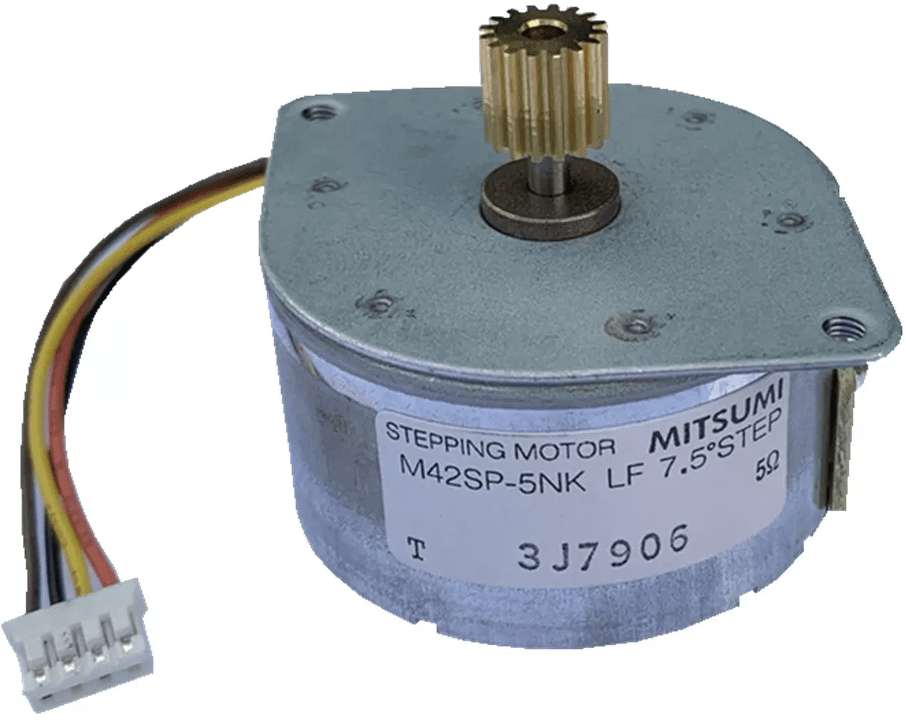

This also works in position 3 and 4; the coil between C and D is energized for position 3, only the current flows in the opposite direction to position 1. The top pole shoe is now the north pole and the bottom one is the south pole. The rotor will now be in position 3. For position 4, the lower coil is energized again and the rotor will rotate to position 4.
The four-speed stepper motor can be stopped every 90 degrees. If this is not sufficient for the application for which the stepper motor is used, it can also be set in eight steps. This is possible with the same stepper motor, only with these intermediate steps both coils will be energized simultaneously.
These intermediate steps can be seen in the image below. These are steps 5 through 8. As you can see, position 5 is in between steps 1 and 2. The same applies to step 6 (between steps 2 and 3) etc. In these intermediate steps, a current flows through both coils.
When the rotor has to be turned to step 5, a current flows in the lower coil from A to B and in the upper coil from C to D. So there are now two north poles (the red pole shoes) and two south poles (the black pole shoes). The rotor will move to position 5.

To allow the rotor to rotate 45 degrees further (to position 2), the diagram of the four-speed stepper motor applies again. The lower coil will then be energized again to allow a current to flow from A to B.
If the stepper motor is then turned 45 degrees further (to position 6), the above image will apply again, where both coils are energized.
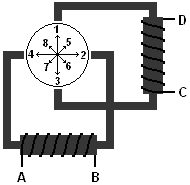
The stepper motor is always controlled by a control unit. The transistors in the driver IC of the control unit provide the power supply and drain to and from the pole shoes. The control unit contains eight transistors. By correctly driving these eight transistors, the stepper motor will make a full revolution in four or eight steps. The rotation can be done in two directions; left and right. The control unit ensures that the correct transistors are turned on.
In the picture we see a stepper motor which is controlled by a control unit. The transistors 1 and 4 are turned on. To clarify the control, the transistors and wires are colored red and brown. Transistor 1 (red) connects terminal A to positive and transistor 4 (brown) connects terminal B to ground.
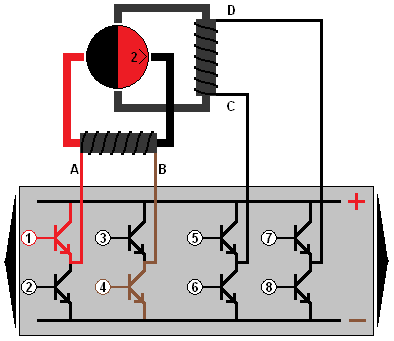
Since the transistors 2 and 3 are not turned on, no current flows through them. If this were the case, a short circuit would occur.
In the picture, the stepper motor is rotated a little further. For this purpose, the transistors 6 and 7 must also be made conductive.
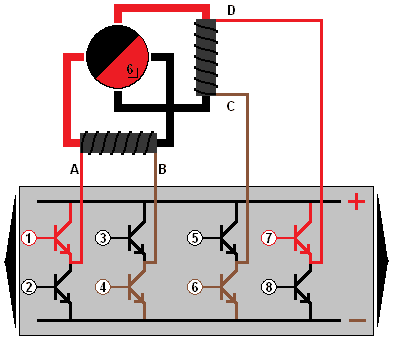
In order to allow the stepper motor to rotate a little further, the conduction of transistors 1 and 4 stops. Only transistors 6 and 7 still conduct, so that the stepper motor assumes position 3.
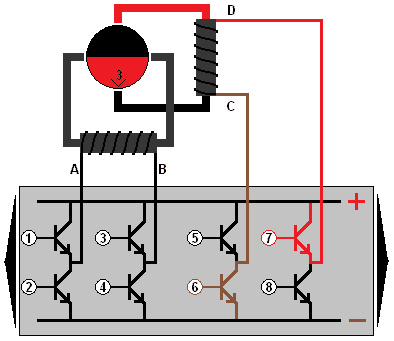
For the next step, transistors 2 and 3 must be turned on.
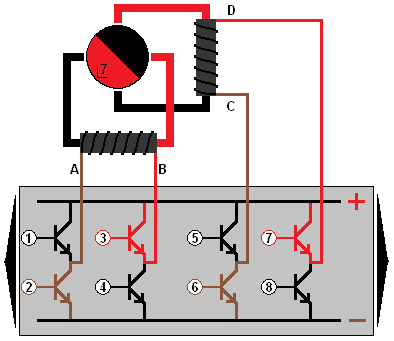
Variable Reluctance Stepper Motor (VR):
Like the permanent magnet stepper motor, the variable reluctance stepper motor contains stator poles with coils. It differs from the previously discussed stepper motor with its toothed rotor made of ferromagnetic metal, such as nickel or iron. That means the rotor is not magnetic. This type of stepper motor is used very little nowadays.
The stator coil on one side (A) is wound the opposite way as the coil on the other side (A'). The same, of course, applies to B and B' etc. The teeth of the rotor are attracted by the magnetic flux created by energizing the stator coils.
The advantages of the VR stepper motor compared to the permanent magnet version are:
- Due to the lack of permanent magnets, the production of the VR stepper motor is less harmful to the environment;
- It is not necessary to reverse the polarity of the stator coils. This allows easier control;
The disadvantages are:
- Low torque;
- low accuracy;
- Higher noise production. The number of applications, including the automotive, are therefore limited;
- Due to the lack of permanent magnets, there is no holding torque at standstill.
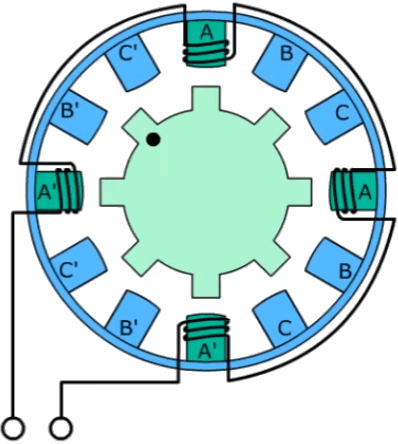
Hybrid stepper motor:
The hybrid stepper motor has a toothed rotor with permanent magnets and an eight-coil toothed stator with a small air gap between the rotor and stator. The rotor consists of two gears that are offset 3,6° from each other. There is a large magnet in the inside of the rotor. Two steel gears are pressed over the magnet. The gears also become magnetic due to the presence of the magnet. One gear is magnetized as the north pole and the other as the south pole. Every tooth on the rotor becomes a magnetic pole. We therefore speak of the “North Pole Rotor” and the “South Pole Rotor”. Due to the shift of the gears, the north and south poles will alternate during rotation. Each sprocket has 50 teeth.
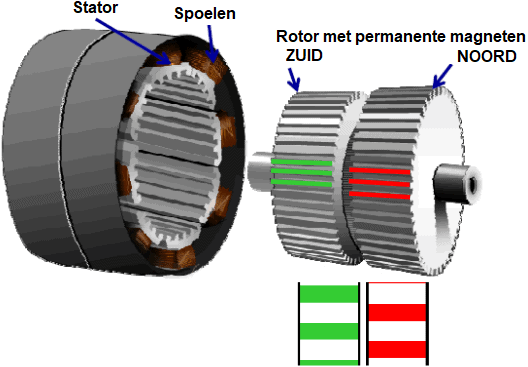
The moment the stepper motor driver allows current to flow through a stator coil, the coil becomes magnetic. The north poles of the coils will attract the south poles of the rotor, causing the rotor to spin.
The three images below show the control of the two phases (red and orange) of the hybrid stepper motor.
A. The rotor of the stepper motor has been rotated to the current position (see the picture) because the coils shown have been made magnetic.
- The green gear is the south pole, which is attracted to the north poles on the stator;
- The teeth between the rotor and stator are in line with each other in the places where the rotor has been pulled. For the sake of clarity, these points are marked with a black mark in all three situations;
- The red gear is behind the green gear. Because the gears are rotated relative to each other, the red teeth are visible. The north poles on the rotor are attracted to the south poles on the stator.
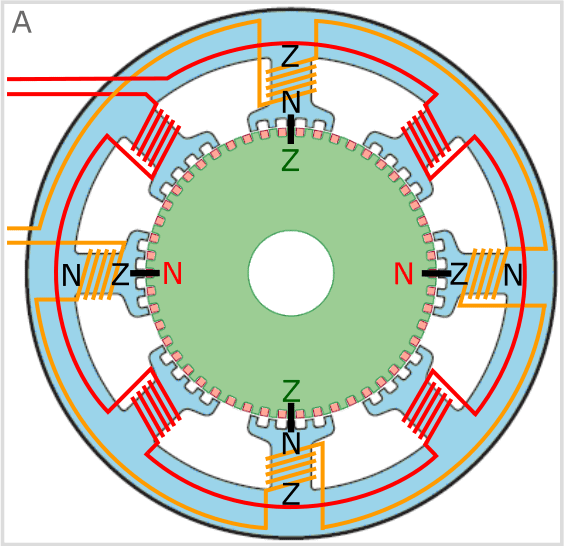
B. The control has switched phase. The magnetic field between the orange coils and the rotor has disappeared. Now the coils of the “red” phase are controlled, so that the magnetic field is built up between the red coils and the rotor.
- As a result of changing the magnetic field from the orange to the red coils, the rotor rotates 1,8° clockwise;
- To make the rotor rotate counterclockwise instead of clockwise, the polarity (direction of current) had to be reversed through the red connections. After all, the direction of current through the coil determines the direction of the magnetic field, and thus the “position” of the north and south poles.
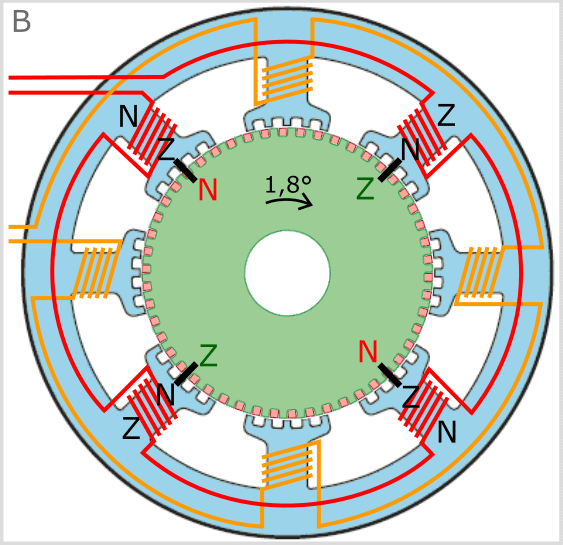
C. The control has changed phase again and the rotor has therefore been turned clockwise again by 1,8°.
- The same coils as in situation A are energized, but the polarity on the orange wires is reversed;
- The rotor can be turned counterclockwise again by driving the coils as shown in situation B;
- To make the rotor turn clockwise, the red coils are also energized, but the polarity is reversed with respect to situation B.
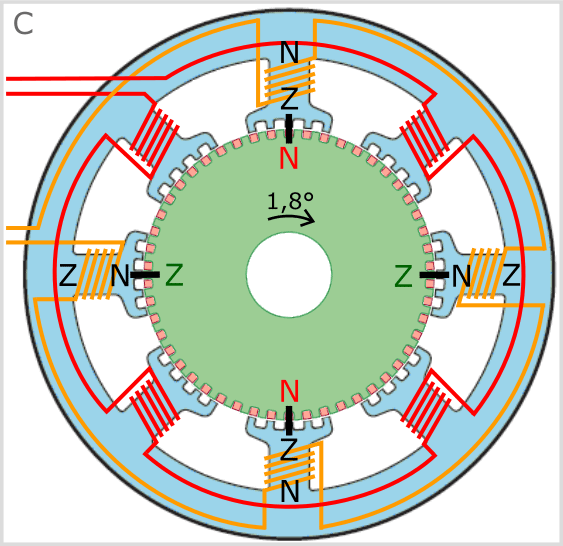
In the above examples, it can be seen that the north pole rotor is attracted to a south pole coil and at the same time the south pole rotor is attracted to a north pole coil. This ensures that the hybrid stepper motor makes very precise movements and also has a high torque.
The hybrid stepper motor can be equipped with more pole pairs and more teeth on the rotor to achieve steps of up to 0,728° and 500 steps per revolution.
